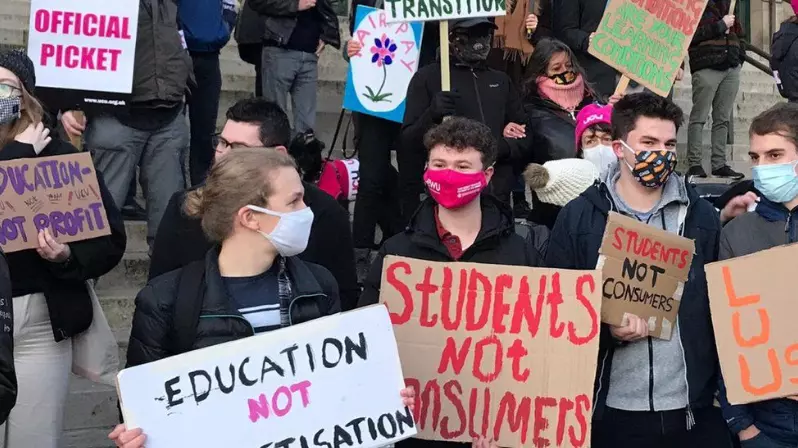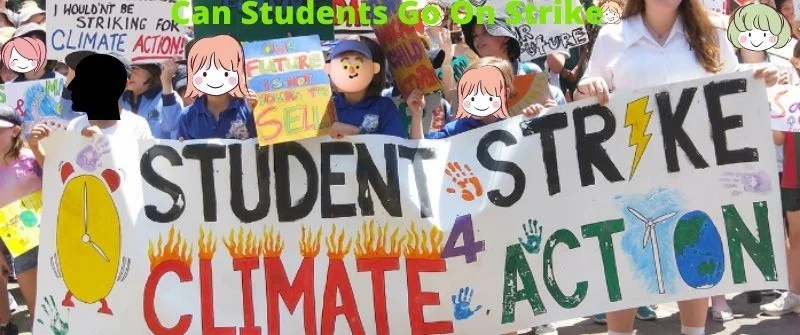A student strike, also known as a student protest or a campus protest, occurs when most students enrolled at a school, college or university decide to skip class on a particular day or refuse to attend class until their issues are resolved.
Faculty members may also choose not to attend, thus closing down an institution. Student strikes can also occur on a local, state, or national level, with hundreds of thousands of students missing class, causing hundreds of campuses to close.
Therefore, a student strike is a kind of student activism that involves protesting on university campuses. Sit-ins, occupations of university offices or buildings, strikes, and other forms of protest are among the options. It is supposed to look like organized labor on strike.
Can Students Go on Strike?
Students can go on student strike if it is within the laws of their state and they have exhausted all other means to air their grievances.
Students going on strike is largely allowed which is sometimes called a boycott of classes, and is a common tactic of student protest and presenting their grievances.
However, this also depends on the rules they signed on to when being admitted to their schools. if it is also allowed under the policies guiding their relationship with the school, then they can protest.
In the West, student protests such as strikes stretch back to the Middle Ages, with the University of Oxford strike of 1209 and the University of Paris strike of 1229, which lasted two years, being two of the earliest.
Student demonstrations occurred more recently in 19th century Europe, including Imperial Russia. Some Polish students opposed anti-Semitic ghetto benches legislation in the 1930s.
Significant demonstrations took place in the late 1960s and early 1970s in the second half of the twentieth century.
The French May 1968 events began with a series of student strikes, and the Polish political crisis the same year witnessed a surge in student involvement.
The most outstanding student strike in American history took place in May and June 1970 in the wake of the American invasion of Cambodia and the killings of student demonstrators at Kent State University in Ohio.
In what became known as the Student Strike of 1970, an estimated four million students from over 450 universities, colleges, and high schools took part.
What Causes Students to Go on Strike?

Students engage in student activism or campus activism to effect political, environmental, economic, or social change.
Some student protests are focused on a specific institution’s internal matters, while others are focused on broader topics such as climate change, dictatorship, or war.
Such protests cover a wide range of activities that reflect student displeasure with a particular political or academic issue and mobilization to transmit that dissatisfaction to the university or civil authorities or both, and society at large, to resolve the issue.
Strikes can also be caused by student misbehavior, drugs, and drunkenness. Some students are also afraid of tests and feel as if they have no purpose in life, leading to them engaging in risky behavior.
Why Students in the US do dot Strike
In the United States, student strikes are rarely the primary method of student action. Students can sit in, demonstrate, march, and occupy quads and buildings. However, they are unlikely to resort to a general strike, utilized in other parts of the world.

Many American students are not aware that striking can be used as a method of protest, as a protest maneuver.
Hence, it would be challenging for organizers to coordinate the large number of students required to succeed.
There has never been an organized, large-scale, national, or near-national student strike in the United States in the recent 40 years.
If there are only a few pupils, they will fail their classes because they are marked absent.
It must be a strategy that can be implemented on a massive scale the first time around. Students are not just influenced by law and history to avoid striking. Today, American students do not strike because they cannot afford to miss class.
Students in the United States now face economic insecurity that did not exist in the 1960s. Tuition has increased as the average student’s financial situation has deteriorated. As a result, they are pinched on both sides. They have a much lower ability to bear the impacts of missing a semester because they will be wrecked if that happens.
Policies of the Different States Regarding Students Striking

In the US, schools can often reprimand students for missing class, even if they are doing it to engage in a protest or otherwise express themselves because almost all jurisdictions compel students to attend school.
However, students have the right to assemble, speak out, distribute fliers and petitions, and wear expressive attire in school — as long as they don’t disrupt the school’s operation or violate the school’s content-neutral regulations.
In the classic case of Tinker v. Des Moines Independent Community School District, the United States Supreme Court established students’ free speech rights at a school.
The First Amendment protects both students’ right to express themselves and their right to join peaceful groups in public spaces to do so. There are many ways to organize a demonstration, but schools have a bit more control over students who are protesting during school hours.
Students have the right to protest during school hours, but if the protest disrupts the learning environment or poses a threat of violence, the school will most likely shut it down. Police and other government authorities are also permitted to impose certain limitations on the use of free speech.
The United States Supreme Court ruled that speech that significantly disrupts or could disrupt a school’s learning environment soon is not protected under the First Amendment.
This includes anything that would jeopardize the school’s educational objective, from blocking other students’ ability to learn in a classroom to put the school on lockdown. The following are examples of actions that would be unprotected:
- A picket line spanning the parking lot that prevents faculty from entering the building
- A sit-in that closes off a hallway, making it impossible for students to get to class
- A protest that occurs during class time and disrupts teaching
Thus, although strikes by students may be legal, the results may be unfavorable. The school, district, or state determines the severity of the student’s punishment. Students need to read through their schools’ and district’s policies to learn more.
Take a look at the policy for unexcused absences if they will miss a class or two. Read up about truancy if they are thinking about missing a few days. In any case, review the suspension policy. Suspension is not an option for unexcused absences in some states and districts.
And nationwide, if a student is facing a suspension of 10 days or longer, they have the right to a formal hearing and can be represented by a lawyer.
A formal process is also required in some states and school districts for fewer days. The student should also be given the same opportunity to work as any other student who has missed class.
Is Going on Strike a Good Thing?
Student protest has always been a part of campus life, from the 1766 Butter Rebellion at Harvard to today’s demands to diversify professors and the student body, expand financial aid ethnic studies classes, remove statues, expand mental health resources, rename buildings, and refund tuition in response to the shift to remote learning.
Proponents of student strikes have suggested that protesting can help students learn more about civics and citizenship. Students can recognize issues of importance in the real world, develop empathy, and propose ideas to tackle them through direct interaction with community issues.
It is critical to recognize that not everything can be learned or comprehended in a classroom. So, attending a protest can provide practical insight into civics education and its application to the world’s current challenges.
Opponents of student strikes argue that when students are allowed to participate in extracurricular activities during school hours, education suffers. Instead of revising coursework, completing examinations, or learning new information, time is spent marching through the streets with placards protesting a specific subject.
Skipping school and failing to meet attendance requirements or missing critical assessment elements can have long-term consequences for students.

Joseph is a freelance journalist and a part-time writer with a particular interest in the gig economy. He writes about schooling, college life, and changing trends in education. When not writing, Joseph is hiking or playing chess.
